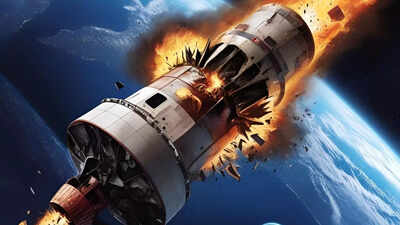Trending
Uncontrolled Soviet spacecraft set to crash back after hovering over the Earth for 50 years; the place of crash is unknown!
A Soviet-era space probe, Kosmos 482, launched in 1972, is set for an uncontrolled return to Earth around May 10, 2025. Originally intended for Venus, a launch malfunction left it orbiting Earth for over 50 years.
When humanity first began reaching for the stars, many spacecraft were launched with ambitious goals but met with failure along the way. Some of these spacecraft that got stranded in orbit have quietly circled Earth for decades, and they remain long forgotten by most only until they suddenly come into everyone’s notice again once they enter the Earth’s atmosphere.
Such is the case with Kosmos 482, a Soviet-era space probe launched over 50 years ago, which is now making an unscheduled, uncontrolled return to Earth.
Unlike satellites that are designed to burn up completely upon re-entry, some older spacecraft were built to survive extreme planetary conditions. These machines, designed with incredible durability, now pose challenges and threats as they re-enter Earth's atmosphere.
It’s a rare situation where old Cold War space ambitions collide with modern-day public safety concerns. Cases like Kosmos 482 are an example of how space debris continues to pose a threat to the Earth after their launch.
How did this spacecraft reach space and stay there for so long?
Originally launched on 31 March 1972 as part of the USSR’s ambitious Venera programme to study Venus, Kosmos 482 was supposed to join its twin, Venera 8, in sending valuable data from Earth’s scorching planetary neighbor. But a malfunction during the launch prevented it from gaining enough velocity to escape Earth’s gravity. Instead, the descent module ended up stuck in an elongated elliptical orbit around Earth, where it has remained for over half a century.
Now, more than 50 years later, this 495-kilogram spacecraft is finally expected to plunge back to Earth around May 10, 2025, though experts say it could be a few days earlier or later. The issue is not just the re-entry, but its uncontrolled nature, which makes it difficult to predict where it will land.
How will the falling spacecraft impact the Earth?
According to Marco Langbroek, a satellite tracker and lecturer at Delft Technical University in the Netherlands, Kosmos 482’s fall is especially concerning due to how it was constructed. “Because the lander was built to withstand the intense pressures and heat of Venus’s atmosphere, it might survive re-entry and reach the ground intact,” Langbroek said on X. He compared the situation to a meteorite impact as “low but not zero” in terms of risk.
Langbroek added that the lander is expected to re-enter at a shallow angle, which adds to the unpredictability. “It will likely re-enter in an unusual, shallow trajectory, making predictions difficult,” he said, suggesting that some parts of the probe could survive the descent through Earth’s atmosphere.
The orbital path of the lander has an inclination of 51.7 degrees, meaning it could come down anywhere between 52 degrees north and 52 degrees south latitude. This covers most of the populated Earth, excluding only the polar regions. While statistically most debris falls into oceans, the possibility of a land impact remains on the table.
The Kosmos 482 probe had split into two parts during the failed mission. The main section burned up upon re-entry back in 1981, but the descent module continued orbiting Earth. And surprisingly, its sister probe Venera 8 successfully landed on Venus in 1972 and transmitted data for 50 minutes before succumbing to the planet’s harsh environment.
End of Article
Follow Us On Social Media
Visual Stories
Tired of too many ads?










